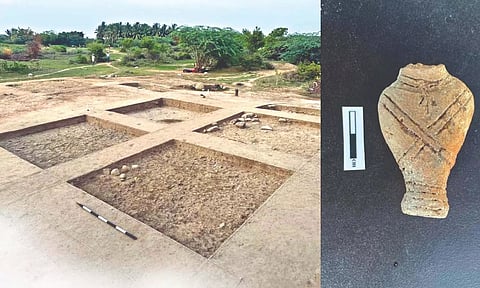

CHENNAI: The Archaeological Survey of India (ASI) recently found around 400 artefacts belonging to the Chola era during an ongoing excavation at Vadakkupattu, Kancheepuram district.
Speaking to DT Next, R Ramesh, an Assistant Archaeologist in in-charge of the Vadakkupattu excavation site, said that the ASI was astonished to find Chola-era artefacts including gold and iron ornaments, horn-shaped jars, pottery with various coloured lines, terracotta toys, beads, pieces of bangles, potsherds, tools and coins on an upper layer of the 40-centimetre pit.
“We started our second phase excavation a month back. Six archaeologists, 20 labourers, one research scholar and a few Madras University students are working here under M Kalimuthu, superintending archaeologist, ASI. As of now, we went up to 40 cm. We will further go up to 1 metre in the next three months. We found around 400 artefacts on the upper layer which belong to the Chola era. There is a possibility to find the artefacts ranging from the early Pallava era (275 CE) to the late Pallavas (897 CE). This site may have been a site of Mesolithic manufacturing. The Vadakkupattu finds show continuous habitation for several thousand years. The new evidence shows it is a culturally and archaeologically important site,” he added.
“Besides the Teri sites at Tirunelveli and Tuticorin districts, Vadakkupattu is the only place in Tamil Nadu where evidence of tools of the Mesolithic period has been found. As per the typological study, the tools may have been made roughly 12,000 years ago. We have sent all these findings for a proper analysis. Carbon dating and thermoluminescence dating will reveal the exact age of the tools. It is unique to find stone tools, artefacts and ornaments belonging to four different eras in a single place,” Ramesh said.
Earlier, in the first phase of excavation (September 2022), the ASI found Roman amphora shards and glass beads indicating active trade with Rome (Sangam era, more than 2,000 years ago) and the team discovered sculptures in the surrounding area which belong to the Pallava era.